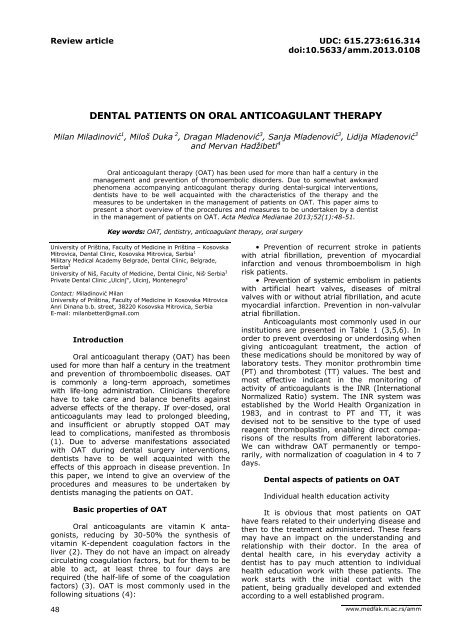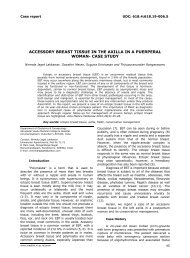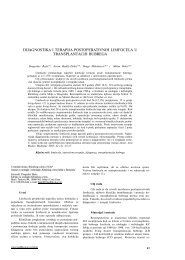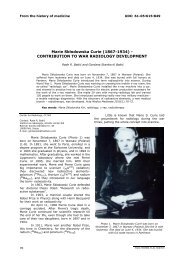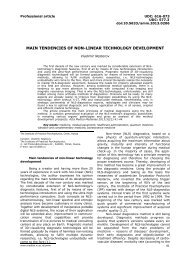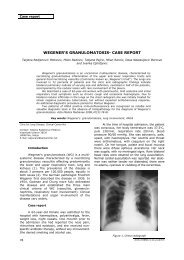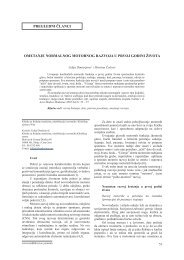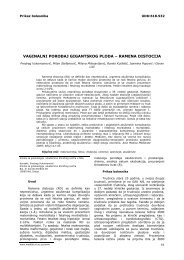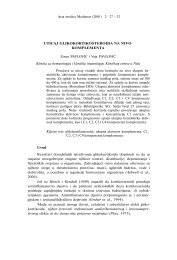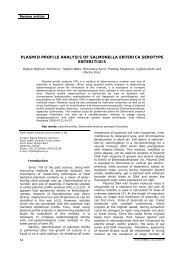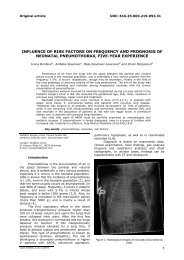ORIGINALNI NAUČNI RADOVI - Acta Medica Medianae
ORIGINALNI NAUČNI RADOVI - Acta Medica Medianae
ORIGINALNI NAUČNI RADOVI - Acta Medica Medianae
You also want an ePaper? Increase the reach of your titles
YUMPU automatically turns print PDFs into web optimized ePapers that Google loves.
Review article UDC: 615.273:616.314<br />
doi:10.5633/amm.2013.0108<br />
DENTAL PATIENTS ON ORAL ANTICOAGULANT THERAPY<br />
Milan Miladinović 1 , Miloš Duka 2 , Dragan Mladenović 3 , Sanja Mladenović 3 , Lidija Mladenović 3<br />
and Mervan Hadžibeti 4<br />
Oral anticoagulant therapy (OAT) has been used for more than half a century in the<br />
management and prevention of thromoembolic disorders. Due to somewhat awkward<br />
phenomena accompanying anticoagulant therapy during dental-surgical interventions,<br />
dentists have to be well acquainted with the characteristics of the therapy and the<br />
measures to be undertaken in the management of patients on OAT. This paper aims to<br />
present a short overview of the procedures and measures to be undertaken by a dentist<br />
in the management of patients on OAT. <strong>Acta</strong> <strong>Medica</strong> <strong>Medianae</strong> 2013;52(1):48-51.<br />
Key words: OAT, dentistry, anticoagulant therapy, oral surgery<br />
University of Priština, Faculty of Medicine in Priština – Kosovska<br />
Mitrovica, Dental Clinic, Kosovska Mitrovica, Serbia 1<br />
Military <strong>Medica</strong>l Academy Belgrade, Dental Clinic, Belgrade,<br />
Serbia 2<br />
University of Niš, Faculty of Medicine, Dental Clinic, Niš , Serbia 3<br />
Private Dental Clinic „Ulcinj“, Ulcinj, Montenegro 4<br />
Contact: Miladinović Milan<br />
University of Priština, Faculty of Medicine in Kosovska Mitrovica<br />
Anri Dinana b.b. street, 38220 Kosovska Mitrovica, Serbia<br />
E-mail: milanbetter@gmail.com<br />
48<br />
Introduction<br />
Oral anticoagulant therapy (OAT) has been<br />
used for more than half a century in the treatment<br />
and prevention of thromboembolic diseases. OAT<br />
is commonly a long-term approach, sometimes<br />
with life-long administration. Clinicians therefore<br />
have to take care and balance benefits against<br />
adverse effects of the therapy. If over-dosed, oral<br />
anticoagulants may lead to prolonged bleeding,<br />
and insufficient or abruptly stopped OAT may<br />
lead to complications, manifested as thrombosis<br />
(1). Due to adverse manifestations associated<br />
with OAT during dental surgery interventions,<br />
dentists have to be well acquainted with the<br />
effects of this approach in disease prevention. In<br />
this paper, we intend to give an overview of the<br />
procedures and measures to be undertaken by<br />
dentists managing the patients on OAT.<br />
Basic properties of OAT<br />
Oral anticoagulants are vitamin K antagonists,<br />
reducing by 30-50% the synthesis of<br />
vitamin K-dependent coagulation factors in the<br />
liver (2). They do not have an impact on already<br />
circulating coagulation factors, but for them to be<br />
able to act, at least three to four days are<br />
required (the half-life of some of the coagulation<br />
factors) (3). OAT is most commonly used in the<br />
following situations (4):<br />
• Prevention of recurrent stroke in patients<br />
with atrial fibrillation, prevention of myocardial<br />
infarction and venous thromboembolism in high<br />
risk patients.<br />
• Prevention of systemic embolism in patients<br />
with artificial heart valves, diseases of mitral<br />
valves with or without atrial fibrillation, and acute<br />
myocardial infarction. Prevention in non-valvular<br />
atrial fibrillation.<br />
Anticoagulants most commonly used in our<br />
institutions are presented in Table 1 (3,5,6). In<br />
order to prevent overdosing or underdosing when<br />
giving anticoagulant treatment, the action of<br />
these medications should be monitored by way of<br />
laboratory tests. They monitor prothrombin time<br />
(PT) and thrombotest (TT) values. The best and<br />
most effective indicant in the monitoring of<br />
activity of anticoagulants is the INR (International<br />
Normalized Ratio) system. The INR system was<br />
established by the World Health Organization in<br />
1983, and in contrast to PT and TT, it was<br />
devised not to be sensitive to the type of used<br />
reagent thromboplastin, enabling direct comparisons<br />
of the results from different laboratories.<br />
We can withdraw OAT permanently or temporarily,<br />
with normalization of coagulation in 4 to 7<br />
days.<br />
Dental aspects of patients on OAT<br />
Individual health education activity<br />
It is obvious that most patients on OAT<br />
have fears related to their underlying disease and<br />
then to the treatment administered. These fears<br />
may have an impact on the understanding and<br />
relationship with their doctor. In the area of<br />
dental health care, in his everyday activity a<br />
dentist has to pay much attention to individual<br />
health education work with these patients. The<br />
work starts with the initial contact with the<br />
patient, being gradually developed and extended<br />
according to a well established program.<br />
www.medfak.ni.ac.rs/amm
<strong>Acta</strong> <strong>Medica</strong> <strong>Medianae</strong> 2013, Vol.52(1)<br />
Dental patients on oral anticoagulant therapy<br />
Table 1. Anticoagulants most commonly used in our country<br />
<strong>Medica</strong>ment Dose T/2 Effect duration Maximum therapeutic effect<br />
Ethylbiscumacetate<br />
‐ Pelentan<br />
‐ Tromexane<br />
Acenocoumarol<br />
‐ Sintrom 1<br />
Acenocoumarol<br />
‐ Sintrom 4<br />
Warfarin sodium<br />
‐ Farin<br />
Phenprocoumon<br />
‐ Marcoumar<br />
300 mg<br />
1 mg<br />
4 mg<br />
5 mg<br />
25-30<br />
hours<br />
8-11<br />
hours<br />
8-11<br />
hours<br />
31-50<br />
hours<br />
4 days 2-3 days<br />
2 days 36-48 hours<br />
2 days 36-48 hours<br />
3 days 36-48 hours<br />
3 mg 6,5 days 4 days 48 hours<br />
A patient has to be warned of any possible<br />
complication in the practice of dentistry and be<br />
aware of possible accompanying events such as<br />
pain, hematoma, bleeding, and other discomforts.<br />
Future visits should be planned, with communication<br />
focusing on the patient motivation to<br />
continue further dental management, offering to<br />
the patients basic knowledge about postoperative<br />
course and possible future dental interventions<br />
(7).<br />
Oral surgery aspects<br />
In the comprehensive review of the<br />
management of patients on OAT, from the point<br />
of view of oral surgery, two problems may be<br />
singled out to be taken care of in parallel:<br />
- underlying/basic disease, as the risk<br />
disease, and<br />
- oral anticoagulant therapy.<br />
Conflicting opinions in the literature as to<br />
these problems have caused case-by-case and<br />
routinized management of oral surgery patients<br />
on OAT. The problem is complex and the reasons<br />
for that are multiple, most common being differing<br />
recommendations related to the underlying disease<br />
by doctors in charge; insufficient education of the<br />
patients as to their disease and anticoagulant<br />
therapy; and insufficient collaboration of dentists<br />
and specialists in charge (7,8).<br />
Significance of team approach<br />
Dental management of patients on OAT is<br />
a complex process, requiring the engagement of<br />
a team of doctors. The team should comprise: a<br />
specialist in charge, transfusiologist, and dentist.<br />
In the team approach to the issue, the underlying<br />
condition (disease) is carefully considered, the<br />
use of appropriate anticoagulants is planned,<br />
their mechanism of action is considered, and OAT<br />
effects are controlled via appropriate laboratory<br />
tests. The duty of a dentist in such a team is to<br />
suggest the most acceptable methods and agents<br />
inducing local anesthesia and local hemostasis<br />
(8,9).<br />
Dental procedures in patients on OAT<br />
The whole concept of the adopted doctrine<br />
of approach to the high risk group of patients on<br />
OAT is based on the presumption that dental<br />
procedures should not provoke the transition of<br />
compensated into decompensated disease phase<br />
or, in other words, the latent disease phase into<br />
manifest, full-blown disease (9).<br />
The risk of significant bleeding in patients<br />
on OAT and with stable INR within the therapeutic<br />
limits (2-4) is very low, while the risk of thrombosis<br />
can be markedly elevated in patients<br />
temporarily withdrawn from anticoagulant therapy.<br />
We should therefore bear in mind the attitude<br />
that oral anticoagulants should not be stopped in<br />
most of the patients planned for outpatient<br />
dental surgery intervention, including tooth<br />
extraction (10).<br />
Dentists should not disrupt with their therapeutic<br />
interventions the continuity of administered<br />
OAT, the OAT being of vital importance for<br />
these patients. Patients on OAT should be managed<br />
in dental clinics or hospitals with departments<br />
of oral surgery or maxillofacial surgery.<br />
Patient admission<br />
The duty of a dentist is to obtain valid<br />
patient history on admission, regardless of the<br />
apparent or real simplicity of the problem. The<br />
data related to the risk disease and possible use<br />
of medication(s) are thus provided. A dentist has<br />
to be able to recognize anticoagulant agents; if<br />
the findings indicate that the patient at hand is<br />
on OAT, adequate patient preparation for dental<br />
intervention should be undertaken. If these are<br />
the patients who have not been examined for a<br />
long time, or the underlying disease has<br />
progressed, the intervention should be planned<br />
and performed with the approval of the physician<br />
treating the underlying disease. If these are well<br />
controlled patients, with fresh findings (not older<br />
than 24 hours) of the indicants of anticoagulant<br />
effect (INR) within the therapeutic values (from<br />
2.0 to 4.0), bleeding can be possibly managed<br />
using local therapeutic measures of hemostasis.<br />
However, in these cases as well, consulting the<br />
physician treating the underlying disease is more<br />
than just desirable; these consultations should be<br />
realized whenever it is feasible. Modern technologies<br />
employed in the practice of telemedicine<br />
may be of particular assistance in that regard,<br />
enabling rapid and simple distant medical consultations<br />
between doctors (11).<br />
49
Dental patients on oral anticoagulant therapy<br />
Miladinović Milan et al.<br />
Choice of the method of anesthesia<br />
Painlessness of a dental intervention is one<br />
of the cornerstones of trust between patients and<br />
their dentists, and a prerequisite for successful<br />
completion of mostly painful or discomforting<br />
dental interventions. Elimination of pain is therefore<br />
a must, accomplished in most cases using<br />
local anesthesia, while in a smaller number of<br />
cases general anesthesia is used.<br />
Local anesthesia is the primary method of<br />
choice, representing one of the safest and<br />
simplest methods in obtaining reversible painlessness<br />
in dentistry practice. Before the use of<br />
local anesthesia it is necessary to check if the<br />
patient is prepared for dental surgery and whether<br />
the INR values are within the therapeutic limits<br />
(2.0-4.0). Values exceeding the upper limit may<br />
lead to the risk of prolonged hemorrhage, even<br />
when only giving local anesthesia. Due to the<br />
injury of tissues, larger and smaller blood vessels<br />
encountered by the needle, prolonged internal<br />
bleeding may occur, leading to the formation of<br />
smaller or larger haematomas and other possible<br />
consequences as well (obstruction of airways,<br />
etc.).<br />
With appropriate preparation and proper<br />
monitoring of vital functions even in most serious<br />
cases, complicated oral surgery interventions<br />
may be done reasonably safely in general<br />
anesthesia (9).<br />
Choice of the method of hemostasis<br />
Dental surgery interventions in patients on<br />
OAT carry a certain degree of risk, possible<br />
hemorrhage or thromboembolic complications. It<br />
is vital that a dentist should be well acquainted<br />
with the procedures of premedication of high risk<br />
patients, being able to adequately apply them. If<br />
a patient is properly prepared before dental<br />
surgery, and hemorrhage occurs after the<br />
intervention, it can be almost always stopped<br />
using the standard methods of hemostasis (9). A<br />
bleeding patient should be carefully examined<br />
and relaxed. If the wound is in question, as<br />
mostly is, the loose coagulum from the wound<br />
surface should be removed, the would should be<br />
examined, left to dry a bit, and artificial<br />
hemostasis is then applied. The methods and<br />
tools of local hemostasis may be combined – a<br />
number of patients on OAT may require special,<br />
systemic measures of hemostasis to be applied in<br />
hospital environment.<br />
The following measures to reduce the risk<br />
of bleeding are recommended in patients on OAT<br />
undergoing oral surgery intervention (10):<br />
• Use of oxidized cellulose (Surgicel) or<br />
collagenous sponges and sutures.<br />
• Washing of the mouth cavity with 5%<br />
tranexamic acid four times a day in the period of<br />
two days (generally, tranexamic acid is rarely<br />
available in primary practice of dentistry).<br />
50<br />
Procedure of dental surgery intervention<br />
The complete procedure of dental surgery<br />
intervention should consist of the steps presented<br />
below (1-10):<br />
A. Preparation before intervention:<br />
- Individual health education activity;<br />
- OAT should not be withdrawn neither<br />
before, nor after the intervention;<br />
- INR result values have to be within the<br />
range 2.0-4.0 on the extraction day. It is thus<br />
recommended to check INR 72 hours before<br />
extraction, and adjust OAT so as to be within the<br />
range 2.0-4.0 on the extraction day (10).<br />
- Antibiotic therapy in the prevention of<br />
bacterial endocarditis, prescribed by a cardiologist<br />
(it usually consists of amoxicillin, ampicillin,<br />
clindamycin and azithromycin (12).<br />
- Written approval by the specialist treating<br />
the underlying risk disease.<br />
B. Intervention:<br />
- Choice of anesthesia method (local anesthesia<br />
is preferred as the safest and simplest approach,<br />
or some of the sedation techniques accompanying<br />
local anesthesia);<br />
- Dental surgery procedure (planned based<br />
on the risk disease, OAT, and patient age);<br />
- Choice of hemostasis method (since pathologic<br />
hemorrhage is in question, with a frail and<br />
delicate blood coagulum, chemical and biologic<br />
resorptive tools are desirable, soaked in an antifibrinolytic<br />
and locally applied, and as required,<br />
other means and methods of local hemostasis may<br />
be used). The use of systemic chemostatics (eg.<br />
vitamin K, etc.) by dentists is contraindicated.<br />
C. Post-surgical course:<br />
- Antibiotic therapy (prescribed according to<br />
the dentist’s assessment, consulting the physician<br />
in charge of the management of underlying<br />
disease);<br />
- Antiinflammatory agents (NSAIDs and COX-2<br />
inhibitors should not be prescribed as analgesics<br />
or antipiretics, which refers especially to brufen<br />
and aspirin);<br />
- Measures of local hemostasis (all the<br />
methods and tools of local hemostasis may be<br />
used, with the priority of resorptive hemostatics<br />
combined with antifibrinolytics; systemic hemostasis<br />
undertaken by a dentist is not permitted);<br />
- Bleeding episodes lasting up to four hours<br />
of oral surgery intervention should be managed<br />
using the measures of local hemostasis; if the<br />
period of time is exceeded, support from a<br />
hematologist or transfusiologist should be<br />
sought, who would stop the bleeding employing<br />
the systemic measures of hemostasis.<br />
Conclusion<br />
Based on the literature data and years of<br />
clinical experience with the patients on OAT for<br />
their original disease, the paper presents a short<br />
overview of the dental treatment of this high risk<br />
patient population. Due to the presence of a<br />
twofold problem in patients with risk diseases on<br />
OAT, the awareness of dentists should be constantly
<strong>Acta</strong> <strong>Medica</strong> <strong>Medianae</strong> 2013, Vol.52(1)<br />
at a very high level, and the recommendations<br />
related to patient admission, preparation for intervention,<br />
dental surgery itself, and post-surgical<br />
management the should be closely abided by.<br />
Acknowledgement<br />
The paper is dedicated to my Old Man (M.M.).<br />
Dental patients on oral anticoagulant therapy<br />
Disclaimer of responsibility<br />
All the advices and information presented in the<br />
paper are believed to be true at the moment of sending<br />
the paper for publication. Neither the author nor<br />
publisher can accept any legal responsibility for the<br />
content and completeness of the guidelines and<br />
recommendations.<br />
References<br />
1. Drewes HW, Lambooij MS, Baan CA, Meijboom BR,<br />
Graafmans WC, Westert GP. Needs and barriers to<br />
improve the collaboration in oral anticoagulant<br />
therapy: a qualitative study. BMC Cardiovasc Disord<br />
2011;11:76. [CrossRef] [PubMed] [PubMedCentr]<br />
2. Schurgers LJ, Shearer MJ, Hamulyák K, Stöcklin E,<br />
Vermeer C. Effect of vitamin K intake on the<br />
stability of oral anticoagulant treatment: doseresponse<br />
relationships in healthy subjects. Blood<br />
2004;104(9): 2682-9. [CrossRef] [PubMed]<br />
3. Paliwal R, Paliwal SR, Agrawal GP, Vyas SP. Recent<br />
advances in search of oral heparin therapeutics. Med<br />
Res Rev 2012; 32(2): 388-409. [CrossRef] [PubMed]<br />
4. Arun G, Sandeep A. Oral Anticoagulation in Clinical<br />
Practice. JIACM 2005; 6(1): 53-66.<br />
5. De Simone N, Sarode R. Diagnosis and management of<br />
common acquired bleeding disorders. Semin Thromb<br />
Hemost 2013; 39(2): 172-81. [CrossRef] [PubMed]<br />
6. Palareti G. Current criteria to determine the<br />
duration of anticoagulant therapy. Recenti Prog Med<br />
2007; 98(12): 603-6. [PubMed]<br />
7. Vujičić B. Oral surgery interventions in patients on anti<br />
coagulant therapy. [dissertation]. Niš: Medicinski<br />
fakultet u Nišu; 1981.<br />
8. Marzan A, Ulrich Somaini S, Bachli E. Discontinuing<br />
oral anticoagulation for elective surgical interventions.<br />
Praxis 2011; 100(23): 1387-92. [CrossRef] [PubMed]<br />
9. Vujičić B et al. Dental surgery aspects of patients on<br />
oral anticoagulant therapy. Niš:Gradina: 1993.<br />
10. Perry DJ, Noakes TJ, Helliwell PS; British Dental<br />
Society. Guidelines for the management of patients<br />
on oral anticoagulants requiring dental surgery. Br<br />
Dent J 2007; 203(7): 389-93. [CrossRef] [PubMed]<br />
11. Dejan Perić, Nebojša Krstić, Goran Tošić, Dragan<br />
Petrović, Slađana Petrović, Zoran Vlahović et al.<br />
Interdisciplinary management of patients with<br />
dental pathology using the method of telemedicine -<br />
case report. <strong>Acta</strong> <strong>Medica</strong> <strong>Medianae</strong> 2012; 51(1): 49-<br />
55. [CrossRef]<br />
12. Gould FK, Elliott TS, Foweraker J, Fulford M, Perry<br />
JD, Roberts GJ et al. Guidelines for the prevention<br />
of endocarditis: report of the Working Party of the<br />
British Society for Antimicrobial Chemotherapy. J<br />
Antimicrob Chemother 2006; 57(6):1035-42. [CrossRef]<br />
[PubMed]<br />
STOMATOLOŠKI PACIJENTI NA ORALNOJ ANTIKOAGULANTNOJ<br />
TERAPIJI<br />
Milan Miladinović, Miloš Duka, Dragan Mladenović, Sanja Mladenović, Lidija Mladenović i<br />
Mervan Hadžibeti<br />
Oralna antikoagulantna terapija (OAT) se koristi više od pola veka u terapiji i<br />
prevenciji tromboembolijskih oboljenja. Zbog nezgodnih manifestacija koje mogu<br />
pratiti oralnu antikoagulantnu terapiju prilikom stomatološko-hirurških intervencija,<br />
stomatolozi moraju biti dobro upoznati sa njenim karakteristikama, ali i merama koje<br />
treba sprovesti kod zdravstvenog zbrinjavanja pacijenata na OAT. Ovaj rad ima za cilj<br />
da pruži kratak osvrt na postupke i mere koje stomatolog treba da ima u vidu kada<br />
zbrinjava pacijenta koji je na OAT. <strong>Acta</strong> <strong>Medica</strong> <strong>Medianae</strong> 2013;52(1):48-51.<br />
Ključne reči: OAT, stomatologija, antikoagulantna terapija, oralna hirurgija<br />
51


